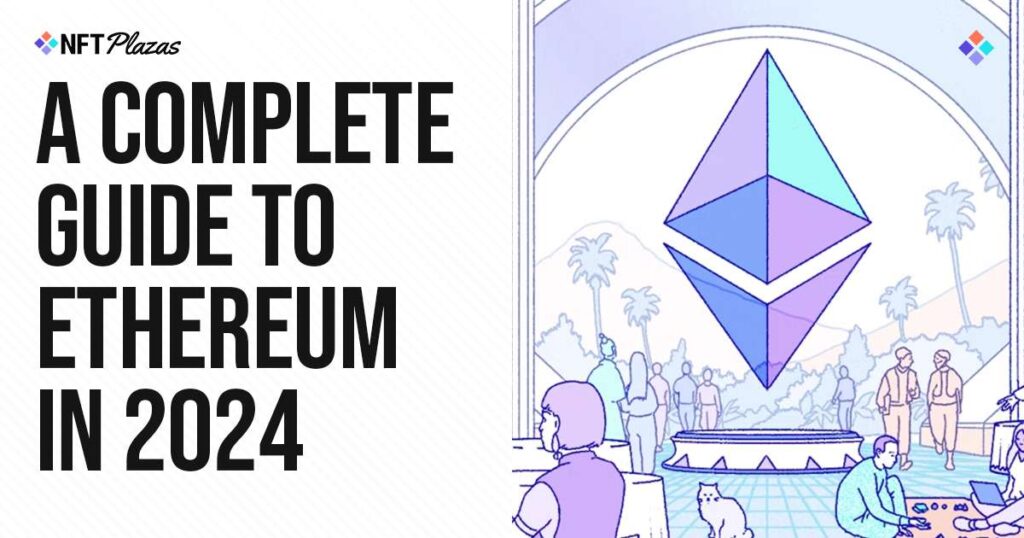A blockchain is at the heart of the modern web3 landscape – Ethereum.
As the first blockchain to support smart contracts and decentralized applications (dApps), Ethereum revolutionized the potential of blockchain technology – today, it forms a solid core for many branches of the industry: NFTs, web3 games , DeFi and more.
Rather than resting on its laurels, Ethereum has a dedicated team of developers who are constantly working to further push the boundaries of web3 technology – but what are these developments? How can Ethereum become an important part of blockchain technology?
Here is our complete guide to Ethereum in 2024.

 Source: Ethereum
Source: EthereumWhat is Ethereum?
Ethereum is the brainchild of Vitalik Buterin, a talented programmer and co-founder of Bitcoin magazine who came up with the idea of a blockchain to support decentralized applications in 2013.
Following a 2014 crowdfunding campaign, Buterin, in collaboration with Gavin Wood, Charles Hoskinson, Anthony Di Iorio, and Joseph Lubin, launched the Layer-1 Ethereum blockchain on July 30, 2015, with Ethereum (ETH) as its operating Tokens.
Ethereum was the first blockchain to allow developers to build dedicated applications for blockchain technology, ushering in a boom period that drove the web3 industry forward. ETH quickly grew to become the second largest cryptocurrency in the world (and still is today) and is the operational core of the blockchain landscape we know today.
As development continued, Ethereum became the core of some of the most influential applications in the ecosystem today, such as OpenSea, Uniswap, and MakerDAO (now Sky). In addition to this, Ethereum was the first blockchain to grow through dedicated layer 2 blockchains such as Polygon and Immutable, allowing areas such as blockchain gaming to flourish.
Now in 2024, Ethereum continues to focus on scalability, cost reduction, and decentralization, with a long-term roadmap aimed at improving and safeguarding the future of the entire blockchain landscape.

 Source: Ethereum
Source: EthereumHow does Ethereum work?
The real innovation of Ethereum is the Ethereum Virtual Machine (EVM), a Turing-complete system that allows developers to write smart contracts that enable the development of blockchain-based applications. These applications are written in Solidity, a smart contract-specific programming language.
The Ethereum blockchain uses a fee structure to execute transactions. Each transaction requires a certain amount of computing power to complete, and users must pay Gas fees (in ETH) to cover the cost of using this computing power. The amount of gas required varies depending on the size of the transaction and how busy the Ethereum network is at the time.
In late 2017, the popularity of CryptoKitties (one of the earliest blockchain games) slowed Ethereum to a crawl and sent gas fees through the roof. Since then, Ethereum has doubled down on its efforts to improve speeds, enhance reliability, and lower fees—the transition from Proof-of-Work to Proof-of-Stake in September 2022 has both significantly slashed Ethereum’s environmental impact and set the stage for Ethereum’s future. laid the foundation.
Today, Ethereum has become the basic blockchain for many emerging Web3 industries, including finance, Web3 games, decentralized social media, supply chain management, and more.

 Source: Ethereum
Source: EthereumThe history of Ethereum
Ethereum’s journey began in late 2013, when Vitalik Buterin released the Ethereum white paper, proposing a blockchain with a built-in programming language—and after gaining traction, coupled with an $18 million crowdfunding effort—the Ethereum mainnet launched in Launched on July 30, 2015.
In 2016, a vulnerability in The DAO smart contract was exploited, resulting in the loss of $50 million worth of ether. To rectify the situation, the community voted for a hard fork, creating two independent blockchains: Ethereum (ETH) and Ethereum Classic (ETC).
Ethereum experienced severe congestion in late 2017 due to the popularity of CryptoKitties, which rejected the creation and popularity of dedicated layer 2 blockchains such as Polygon and Immutable, and made way for new layer 1 blockchain groups such as Flow, Avalanche and Solana.
One of the most critical upgrades in the history of Ethereum occurred in September 2022. The “merger” transitioned Ethereum from Proof-of-Work to Proof-of-Stake, reduced Ethereum’s energy consumption by 99%, laid the foundation for new validators, and is the first step in helping to cut gas bills – at the time of writing this article Gas prices are at their lowest ever.
Ethereum’s most recent major update, Dencun, was carried out in March 2024 and was designed to reduce the fees of the layer 2 network. This is the latest update designed to improve scalability, reliability and user experience, future-proof the industry and work towards the future of “Ethereum 2.0”.
In July 2024, Ethereum became the second cryptocurrency approved by the U.S. SEC as an exchange-traded fund (ETF). The Ethereum ETF exposed the blockchain and ETH cryptocurrency to numerous institutional investors and millions of ordinary people around the world.
As Ethereum continues to innovate, its influence as a leader in blockchain technology and the digital economy will only grow. Although competition in the Layer-1 environment is more intense than ever in 2024, Ethereum remains firmly in the lead as the leading smart contract blockchain, and it will continue to be the cornerstone of the web3 industry for many years to come.

